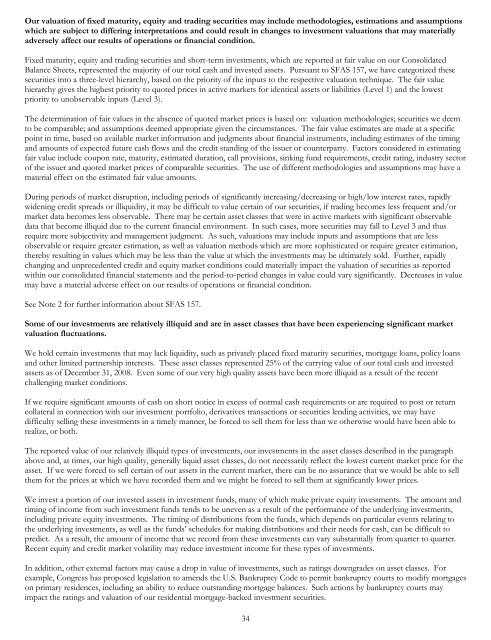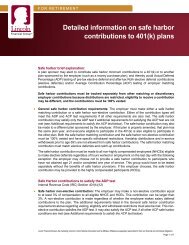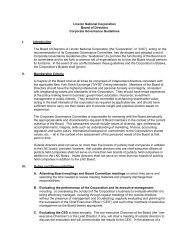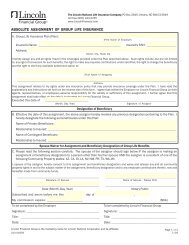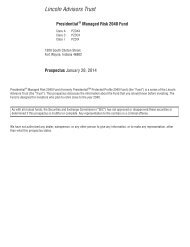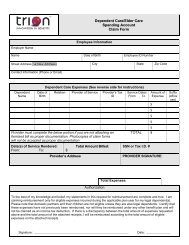2008 Annual Report to Shareholders - Lincoln Financial Group
2008 Annual Report to Shareholders - Lincoln Financial Group
2008 Annual Report to Shareholders - Lincoln Financial Group
You also want an ePaper? Increase the reach of your titles
YUMPU automatically turns print PDFs into web optimized ePapers that Google loves.
Our valuation of fixed maturity, equity and trading securities may include methodologies, estimations and assumptions<br />
which are subject <strong>to</strong> differing interpretations and could result in changes <strong>to</strong> investment valuations that may materially<br />
adversely affect our results of operations or financial condition.<br />
Fixed maturity, equity and trading securities and short-term investments, which are reported at fair value on our Consolidated<br />
Balance Sheets, represented the majority of our <strong>to</strong>tal cash and invested assets. Pursuant <strong>to</strong> SFAS 157, we have categorized these<br />
securities in<strong>to</strong> a three-level hierarchy, based on the priority of the inputs <strong>to</strong> the respective valuation technique. The fair value<br />
hierarchy gives the highest priority <strong>to</strong> quoted prices in active markets for identical assets or liabilities (Level 1) and the lowest<br />
priority <strong>to</strong> unobservable inputs (Level 3).<br />
The determination of fair values in the absence of quoted market prices is based on: valuation methodologies; securities we deem<br />
<strong>to</strong> be comparable; and assumptions deemed appropriate given the circumstances. The fair value estimates are made at a specific<br />
point in time, based on available market information and judgments about financial instruments, including estimates of the timing<br />
and amounts of expected future cash flows and the credit standing of the issuer or counterparty. Fac<strong>to</strong>rs considered in estimating<br />
fair value include coupon rate, maturity, estimated duration, call provisions, sinking fund requirements, credit rating, industry sec<strong>to</strong>r<br />
of the issuer and quoted market prices of comparable securities. The use of different methodologies and assumptions may have a<br />
material effect on the estimated fair value amounts.<br />
During periods of market disruption, including periods of significantly increasing/decreasing or high/low interest rates, rapidly<br />
widening credit spreads or illiquidity, it may be difficult <strong>to</strong> value certain of our securities, if trading becomes less frequent and/or<br />
market data becomes less observable. There may be certain asset classes that were in active markets with significant observable<br />
data that become illiquid due <strong>to</strong> the current financial environment. In such cases, more securities may fall <strong>to</strong> Level 3 and thus<br />
require more subjectivity and management judgment. As such, valuations may include inputs and assumptions that are less<br />
observable or require greater estimation, as well as valuation methods which are more sophisticated or require greater estimation,<br />
thereby resulting in values which may be less than the value at which the investments may be ultimately sold. Further, rapidly<br />
changing and unprecedented credit and equity market conditions could materially impact the valuation of securities as reported<br />
within our consolidated financial statements and the period-<strong>to</strong>-period changes in value could vary significantly. Decreases in value<br />
may have a material adverse effect on our results of operations or financial condition.<br />
See Note 2 for further information about SFAS 157.<br />
Some of our investments are relatively illiquid and are in asset classes that have been experiencing significant market<br />
valuation fluctuations.<br />
We hold certain investments that may lack liquidity, such as privately placed fixed maturity securities, mortgage loans, policy loans<br />
and other limited partnership interests. These asset classes represented 25% of the carrying value of our <strong>to</strong>tal cash and invested<br />
assets as of December 31, <strong>2008</strong>. Even some of our very high quality assets have been more illiquid as a result of the recent<br />
challenging market conditions.<br />
If we require significant amounts of cash on short notice in excess of normal cash requirements or are required <strong>to</strong> post or return<br />
collateral in connection with our investment portfolio, derivatives transactions or securities lending activities, we may have<br />
difficulty selling these investments in a timely manner, be forced <strong>to</strong> sell them for less than we otherwise would have been able <strong>to</strong><br />
realize, or both.<br />
The reported value of our relatively illiquid types of investments, our investments in the asset classes described in the paragraph<br />
above and, at times, our high quality, generally liquid asset classes, do not necessarily reflect the lowest current market price for the<br />
asset. If we were forced <strong>to</strong> sell certain of our assets in the current market, there can be no assurance that we would be able <strong>to</strong> sell<br />
them for the prices at which we have recorded them and we might be forced <strong>to</strong> sell them at significantly lower prices.<br />
We invest a portion of our invested assets in investment funds, many of which make private equity investments. The amount and<br />
timing of income from such investment funds tends <strong>to</strong> be uneven as a result of the performance of the underlying investments,<br />
including private equity investments. The timing of distributions from the funds, which depends on particular events relating <strong>to</strong><br />
the underlying investments, as well as the funds’ schedules for making distributions and their needs for cash, can be difficult <strong>to</strong><br />
predict. As a result, the amount of income that we record from these investments can vary substantially from quarter <strong>to</strong> quarter.<br />
Recent equity and credit market volatility may reduce investment income for these types of investments.<br />
In addition, other external fac<strong>to</strong>rs may cause a drop in value of investments, such as ratings downgrades on asset classes. For<br />
example, Congress has proposed legislation <strong>to</strong> amends the U.S. Bankruptcy Code <strong>to</strong> permit bankruptcy courts <strong>to</strong> modify mortgages<br />
on primary residences, including an ability <strong>to</strong> reduce outstanding mortgage balances. Such actions by bankruptcy courts may<br />
impact the ratings and valuation of our residential mortgage-backed investment securities.<br />
34


